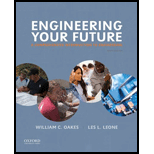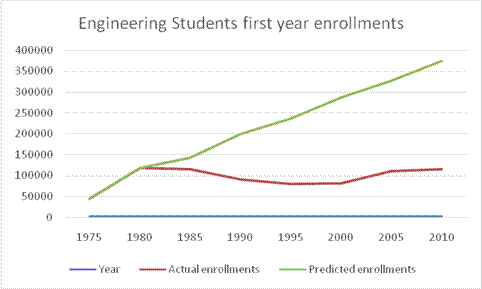
The number of first-year, full-time enrollments expected in 2010 if the administrator used the data from 1975 to 1980 and to calculate the percentage error.
Answer to Problem 3.1EAA
The number of first-year full time enrollments expected in 2010 if the administrator used the data from 1975 to 1980 as 375000 students and the percentage error is 226%.
Explanation of Solution
Given information:
As per the given data, to find the error percentage upon usage of the data from 1975 to 1980 to predict the number of first-year full time enrollments expected in 2010.
According to the data in the Engineering for your future book, the following table illustrates the actual data for the years 1975 to 2010 and the predicted data for the year 2010 using only the estimates from 1975 to 1980.
| Year | Actual enrollments | Predicted enrollments |
| 1975 | 45000 | 45000 |
| 1980 | 118000 | 118000 |
| 1985 | 115000 | 143000 |
| 1990 | 90000 | 200000 |
| 1995 | 80000 | 237000 |
| 2000 | 82000 | 287000 |
| 2005 | 110000 | 328000 |
| 2010 | 115000 | 375000 |
The following is a graphical illustration of the same data in the table:

The above graph shows huge differences in the predicted data since it has taken the data belonging to the years 1975 to 1980 and prorated the same to the rest of the years until 2010. By doing this, the administrator has missed few important factors like the number of births every year; number of high school graduates every year, and other economic factors. These factors tend to change year after year and by taking only the data from 1975 to 1980, the number of enrollments for several years cannot be predicted accurately.
The percentage of error can be calculated as:
Percentage error
This shows that there is a huge percentage error upon the usage of the data from 1975 to 1980 to predict the number of first-year full time enrollments expected in 2010.
Conclusion:
Thus, the number of first year full-time enrollments expected in 2010 if the administrator used the data from 1975 to 1980 and the percentage error is discussed in details.
Want to see more full solutions like this?
- What is the critical speed of the shaft in rad/s for one, two, and three elements?arrow_forward2. Express the following complex numbers in rectangular form. (a) z₁ = 2еjл/6 (b) Z2=-3e-jπ/4 (c) Z3 = √√√3e-j³/4 (d) z4 = − j³arrow_forwardA prismatic beam is built into a structure. You can consider the boundary conditions at A and B to be fixed supports. The beam was originally designed to withstand a triangular distributed load, however, the loading condition has been revised and can be approximated by a cosine function as shown in the figure below. You have been tasked with analysing the structure. As the beam is prismatic, you can assume that the bending rigidity (El) is constant. wwo cos 2L x A B Figure 3: Built in beam with a varying distributed load In order to do this, you will: a. Solve the reaction forces and moments at point A and B. Hint: you may find it convenient to use the principal of superposition. (2%) b. Plot the shear force and bending moment diagrams and identify the maximum shear force and bending moment. (2%) c. Develop an expression for the vertical deflection. Clearly state your expression in terms of x. (1%)arrow_forward
- Question 1: Beam Analysis Two beams (ABC and CD) are connected using a pin immediately to the left of Point C. The pin acts as a moment release, i.e. no moments are transferred through this pinned connection. Shear forces can be transferred through the pinned connection. Beam ABC has a pinned support at point A and a roller support at Point C. Beam CD has a roller support at Point D. A concentrated load, P, is applied to the mid span of beam CD, and acts at an angle as shown below. Two concentrated moments, MB and Mc act in the directions shown at Point B and Point C respectively. The magnitude of these moments is PL. Moment Release A B с ° MB = PL Mc= = PL -L/2- -L/2- → P D Figure 1: Two beam arrangement for question 1. To analyse this structure, you will: a) Construct the free body diagrams for the structure shown above. When constructing your FBD's you must make section cuts at point B and C. You can represent the structure as three separate beams. Following this, construct the…arrow_forwardA cantilevered rectangular prismatic beam has three loads applied. 10,000N in the positive x direction, 500N in the positive z direction and 750 in the negative y direction. You have been tasked with analysing the stresses at three points on the beam, a, b and c. 32mm 60mm 24mm 180mm 15mm 15mm 40mm 750N 16mm 500N x 10,000N Figure 2: Idealisation of the structure and the applied loading (right). Photograph of the new product (left). Picture sourced from amazon.com.au. To assess the design, you will: a) Determine state of stress at all points (a, b and c). These points are located on the exterior surface of the beam. Point a is located along the centreline of the beam, point b is 15mm from the centreline and point c is located on the edge of the beam. When calculating the stresses you must consider the stresses due to bending and transverse shear. Present your results in a table and ensure that your sign convention is clearly shown (and applied consistently!) (3%) b) You have identified…arrow_forward7.82 Water flows from the reservoir on the left to the reservoir on the right at a rate of 16 cfs. The formula for the head losses in the pipes is h₁ = 0.02(L/D)(V²/2g). What elevation in the left reservoir is required to produce this flow? Also carefully sketch the HGL and the EGL for the system. Note: Assume the head-loss formula can be used for the smaller pipe as well as for the larger pipe. Assume α = 1.0 at all locations. Elevation = ? 200 ft 300 ft D₁ = 1.128 ft D2=1.596 ft 12 2012 Problem 7.82 Elevation = 110 ftarrow_forward
- Homework#5arrow_forwardA closed-cycle gas turbine unit operating with maximum and minimum temperature of 760oC and 20oC has a pressure ratio of 7/1. Calculate the ideal cycle efficiency and the work ratioarrow_forwardConsider a steam power plant that operates on a simple, ideal Rankine cycle and has a net power output of 45 MW. Steam enters the turbine at 7 MPa and 500°C and is cooled in the condenser at a pressure of 10 kPa by running cooling water from a lake through the tubes of the condenser at a rate of 2000 kg/s. Show the cycle on a T-s diagram with respect to saturation lines, and determine The thermal efficiency of the cycle,The mass flow rate of the steam and the temperature rise of the cooling waterarrow_forwardTwo reversible heat engines operate in series between a source at 600°C, and a sink at 30°C. If the engines have equal efficiencies and the first rejects 400 kJ to the second, calculate: the temperature at which heat is supplied to the second engine, The heat taken from the source; and The work done by each engine. Assume each engine operates on the Carnot cyclearrow_forwardA steam turbine operates at steady state with inlet conditions of P1 = 5 bar, T1 = 320°C. Steam leaves the turbine at a pressure of 1 bar. There is no significant heat transfer between the turbine and its surroundings, and kinetic and potential energy changes between inlet and exit are negligible. If the isentropic turbine efficiency is 75%, determine the work developed per unit mass of steam flowing through the turbine, in kJ/kgarrow_forwardHomework#5arrow_forwardarrow_back_iosSEE MORE QUESTIONSarrow_forward_iosRecommended textbooks for you
 Elements Of ElectromagneticsMechanical EngineeringISBN:9780190698614Author:Sadiku, Matthew N. O.Publisher:Oxford University Press
Elements Of ElectromagneticsMechanical EngineeringISBN:9780190698614Author:Sadiku, Matthew N. O.Publisher:Oxford University Press Mechanics of Materials (10th Edition)Mechanical EngineeringISBN:9780134319650Author:Russell C. HibbelerPublisher:PEARSON
Mechanics of Materials (10th Edition)Mechanical EngineeringISBN:9780134319650Author:Russell C. HibbelerPublisher:PEARSON Thermodynamics: An Engineering ApproachMechanical EngineeringISBN:9781259822674Author:Yunus A. Cengel Dr., Michael A. BolesPublisher:McGraw-Hill Education
Thermodynamics: An Engineering ApproachMechanical EngineeringISBN:9781259822674Author:Yunus A. Cengel Dr., Michael A. BolesPublisher:McGraw-Hill Education Control Systems EngineeringMechanical EngineeringISBN:9781118170519Author:Norman S. NisePublisher:WILEY
Control Systems EngineeringMechanical EngineeringISBN:9781118170519Author:Norman S. NisePublisher:WILEY Mechanics of Materials (MindTap Course List)Mechanical EngineeringISBN:9781337093347Author:Barry J. Goodno, James M. GerePublisher:Cengage Learning
Mechanics of Materials (MindTap Course List)Mechanical EngineeringISBN:9781337093347Author:Barry J. Goodno, James M. GerePublisher:Cengage Learning Engineering Mechanics: StaticsMechanical EngineeringISBN:9781118807330Author:James L. Meriam, L. G. Kraige, J. N. BoltonPublisher:WILEY
Engineering Mechanics: StaticsMechanical EngineeringISBN:9781118807330Author:James L. Meriam, L. G. Kraige, J. N. BoltonPublisher:WILEY
 Elements Of ElectromagneticsMechanical EngineeringISBN:9780190698614Author:Sadiku, Matthew N. O.Publisher:Oxford University Press
Elements Of ElectromagneticsMechanical EngineeringISBN:9780190698614Author:Sadiku, Matthew N. O.Publisher:Oxford University Press Mechanics of Materials (10th Edition)Mechanical EngineeringISBN:9780134319650Author:Russell C. HibbelerPublisher:PEARSON
Mechanics of Materials (10th Edition)Mechanical EngineeringISBN:9780134319650Author:Russell C. HibbelerPublisher:PEARSON Thermodynamics: An Engineering ApproachMechanical EngineeringISBN:9781259822674Author:Yunus A. Cengel Dr., Michael A. BolesPublisher:McGraw-Hill Education
Thermodynamics: An Engineering ApproachMechanical EngineeringISBN:9781259822674Author:Yunus A. Cengel Dr., Michael A. BolesPublisher:McGraw-Hill Education Control Systems EngineeringMechanical EngineeringISBN:9781118170519Author:Norman S. NisePublisher:WILEY
Control Systems EngineeringMechanical EngineeringISBN:9781118170519Author:Norman S. NisePublisher:WILEY Mechanics of Materials (MindTap Course List)Mechanical EngineeringISBN:9781337093347Author:Barry J. Goodno, James M. GerePublisher:Cengage Learning
Mechanics of Materials (MindTap Course List)Mechanical EngineeringISBN:9781337093347Author:Barry J. Goodno, James M. GerePublisher:Cengage Learning Engineering Mechanics: StaticsMechanical EngineeringISBN:9781118807330Author:James L. Meriam, L. G. Kraige, J. N. BoltonPublisher:WILEY
Engineering Mechanics: StaticsMechanical EngineeringISBN:9781118807330Author:James L. Meriam, L. G. Kraige, J. N. BoltonPublisher:WILEY